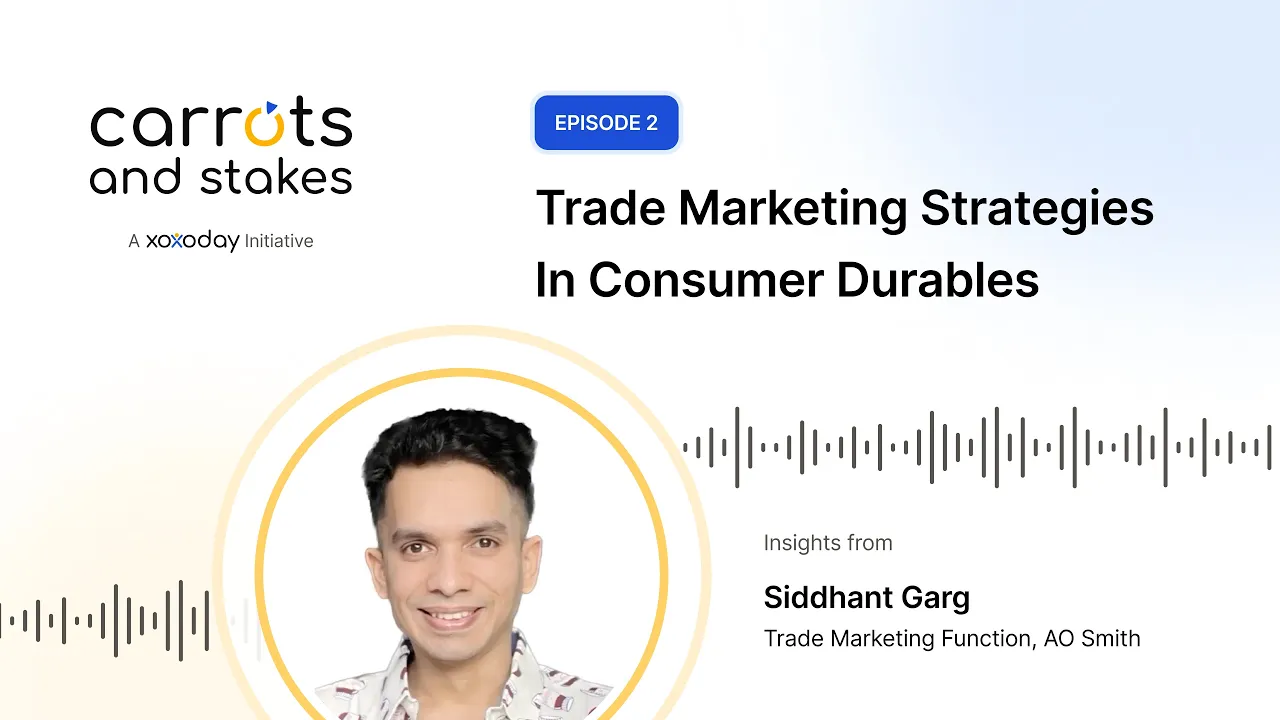Trade Marketing Strategies | Insights from Siddhant Garg
Perkenalan
DJ: Hello everyone, welcome to another episode of Carrots and Stakes. I’m your host, DJ, and today we have Sidhant G with us. Sidhant is currently heading the trade marketing function at AOS Smith and has previously worked with brands like Pidilite and Philip Morris. Welcome to the show, Sidhant!
Sidhant: Thank you, DJ. This is my first podcast, so I’m both excited and a bit nervous.
DJ: No worries, we’ll make it fun and insightful for everyone listening. Let’s dive right in!
Designing Trade Marketing Strategies for Long-Term Success
DJ: Trade marketing is a critical function, especially when it comes to building relationships with channel partners like distributors and retailers. How do you design trade marketing strategies that not only boost short-term sales but also build long-term loyalty among your partners?
Sidhant: Trade partners are essentially the custodians of your brand. To build a long-term, sustainable strategy, the first step is to step out of the office and connect with them regularly. This helps them feel valued and heard.
Our strategy revolves around four key pillars:
1. Lucrative Trade Schemes: Offering incentives that make economic sense for partners.
2. Clutter-Breaking Visibility: Ensuring our brand stands out in a crowded market.
3. Demand Generation Activations: Engaging customers at storefronts and local events.
4. Local Event Presence: Building a connection with the community.
By combining these elements, we foster a long-term relationship where partners grow alongside the brand.
Motivating Channel Partners to Prioritize Your Brand
DJ: Incentives play a big role in motivating channel partners. What’s the best way to ensure they prioritize your product over competitors?
Sidhant: While incentives are important, we avoid making the relationship purely transactional. Instead, we focus on three key areas:
1. Clear Brand Ideology: Ensuring all collaterals, from catalogs to in-shop displays, communicate our value proposition consistently.
2. Unique Selling Proposition (USP): Highlighting what sets us apart from competitors. For example, if we emphasize premiumness, our designs and messaging reflect that subtly yet effectively.
3. Two-Way Communication: Building a partnership where feedback from trade partners is actively considered and implemented.
This approach ensures that the relationship goes beyond just transactions and becomes a true partnership.
Enhancing Trade Visibility in a Cluttered Market
DJ: Trade visibility is crucial, but with so many brands competing for the same space, how do you capture consumer attention effectively?
Sidhant: Visibility is indeed the cornerstone of trade marketing. Instead of just benchmarking against competitors, we scan the market from a neutral perspective, often drawing inspiration from unrelated categories.
For example, we adapted a mobile display concept from the fan industry for our water heaters and purifiers. These mobile units can be placed outside stores, capturing the attention of both store visitors and passersby. This innovation eliminated the need for fixed wall space and increased our brand visibility significantly.
The key is to stay observant and adapt innovative ideas from other industries to your specific category.
Balancing Seasonal and Off-Season Visibility
DJ: For seasonal products, how do you balance visibility during peak and off-peak periods?
Sidhant: Even during the off-season, visibility is about creating a constant recall in the consumer’s mind. For instance, a customer might see our product in summer but only purchase it in winter. By maintaining visibility year-round, we ensure our brand stays in their consideration set.
It’s not just about capturing the immediate buyer but also about staying top-of-mind for future purchases.
The Role of Data in Trade Marketing Decisions
DJ: Data plays a huge role in shaping trade marketing strategies. Can you share an example where data insights changed your approach?
Sidhant: Data is crucial, but it’s equally important to validate it with ground reality. For example, if a product is performing exceptionally well in certain regions or stores, we dig deeper to understand why. Is it because of a booming subcategory, or is there an opportunity to expand further?
By marrying data with on-ground insights, we tailor our strategies to maximize growth and address gaps effectively.
Future Trends in Trade Marketing
DJ: What’s the next big thing in trade marketing that brands should prepare for?
Sidhant: One emerging trend is the concept of second-screen enough, where digital and offline marketing efforts are seamlessly integrated. For example, a customer might see a brand on Instagram and then recognize it in a store. The story between digital and offline marketing needs to be consistent.
Another trend is the shift from static to dynamic digital displays. These displays can be customized at a city or even pin-code level, showing only relevant products to customers. This level of personalization helps simplify decision-making and enhances the customer experience.
Closing Remarks
DJ: Thank you, Sidhant, for sharing such valuable insights. Two key takeaways from our conversation are the importance of brand recall and the integration of digital and offline marketing.
Sidhant: Thank you, DJ. Engaging in these conversations always helps refine strategies and think from new perspectives. I look forward to more such interactions.
DJ: Absolutely! Thank you, everyone, for tuning in. Stay tuned for more episodes of Carrots and Stakes.

Most recent episodes
Dapatkan pemberitahuan setiap kali kami memposting episode baru

Berlangganan sekarang dan dapatkan pembaruan instan setiap kali ada episode baru.












.jpg)




.jpg)
